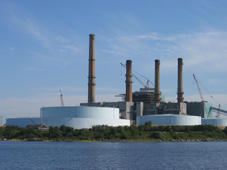 |
Mount
Hope Bay Natural Laboratory
(MHBNL) |
The Mt. Hope Bay Natural Laboratory (MHBNL)
developed through three major phases: 1) designing the
framework, 2) developing a model system, and 3) conducting
the field surveys to validate the model system.
Phase I covered the time period from July 2001 to June
2003, with a focus on a) assessing, assembling,
and synthesizing historical field and modeling works accomplished
in the Mt. Hope Bay region and b) designing the
framework for formulating the laboratory. Phase 2 covered
a time period from July 2003 to June 2004, with focus
on a) the development of an integrated Mt. Hope
Bay model system tool and b) the simulation of
the realistic hydrodynamic field in the bay. Phase III
started in July 2004 and continues to present, with a
focus on the field measurement for the purpose of the
model validation and assessment of the relative impact
of natural (climate-warming) and anthropogenic (thermal
plume) factors on the bay environment.
The initial plan of MHBNL was to develop
a model system by building a model system network with
existing hydrographic models in this region. A careful
assessment on existing models was made in phase I and
process-oriented study showed that the hydrodynamic system
in the Mt Hope Bay is controlled by strong tidal flushing
through narrow straits linking to Narragansett Bay and
Sakonnet River, multi-river discharges, cooling water
outflow, and variable meteorological forcing. Due to the
limitation in geometric fitting and horizontal resolution,
none of existing models are capable to resolve the complex
circulation system in the Mt. Hope Bay. Instead of the
initial plan, we introduced an unstructured grid, finite-volume
coastal ocean model (FVCOM) to the Mt. Hope Bay and used
it as a framework to build a high resolution integrated
atmospheric-ocean-ecosystem model system for this bay.
This is the first inner bay model system that is capable
of resolving irregular geometric structure and strongly
tidal flushing and eddy shedding in Massachusetts and
Rhode Island. Mass conservative unstructured grid finite-volume
numerical technology used in this system leads this field
of coastal and estuarine modeling and the accuracy and
reality produced by this system make it capable to be
used as a reliable environmental assessment and monitoring
tool.
A model-validation field survey was
carried by a multi-institutional cooperative effort of
UMASSD and Woods Hole Oceanographic Institution (WHOI)
in August 2005. This field work was led by Dr. Liuzhi
Zhao with assistance from Drs. Changsheng Chen, Geoffrey
Cowles and Don MacDonald (UMASSD) and Jim Churchill (WHOI).
The measurement was focused on mapping the hot-water plume
and locating tidal flushing-induced eddies. In the mapping
survey, a high-resolution tow-yo CTD/ADCP measurement
was made repeatedly in a tracking array covering an area
from the exit of the hot-water discharge channel to the
plume boundary in MHB. Two satellite-tracking surface
drifters, operated by Jim Churchill at WHOI and Dr. Geoffrey
Cowles at UMASSD, were released at the exit of the hot-water
discharge during the cruise to mapping the recirculation
cells due to the lateral shear instability of the jet
current. In the eddy survey, a CTD/ADCP measurement
was made at pre-designed stations and repeatedly continuous
tracks in an area where the eddy formed. Two satellite-tracking
surface drifters were released in the NB/MHB channel during
the flood tide to determine the current separation due
to strong tidal flushing. A broad-scale coverage of MHB
area made in the third survey provides an unique high
resolution data for the model system validation.
The MHBNL is operated by a team effort
of scientists at SMAST through collaboration with scientists
at WHOI (for the field measurement). Brian Rothschild
is Principal Investigator. The members of the model team
include Dr. Changhsheng Chen (in charge of the modeling
management). Dr. Liuzhi Zhao (Research Scientist in charge
of the model development, numerical experiments and field
measurement/data processing) and Dr. Geoffery Cowles (Research
Scientist in charge of the code parallelization). |